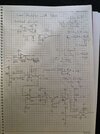Fluffyboii
Active Member
Circuit requires some DC offset so I implemented a summing amplifier. The thing I am not understanding is to how to choose resistor values.
Looking at the graph for 6V I need 460 ohm led resistor. Can I impose my input signal over 5.5V DC like this and calculate for 5.5V + 0.5V signal. The servo photo diodes are even more confusing since its gain is very low acording to datasheet. Shouldn't currents passing through both of them be the same. At 10mA "If" current 100uF is passing through photo diode so how can I pick the R1 and R2 values according to this information. Should I just use 60K so that 100uA is passing through the resistor or is there a other way of calculating this. The op amp setup with no feedback is confusing too.


